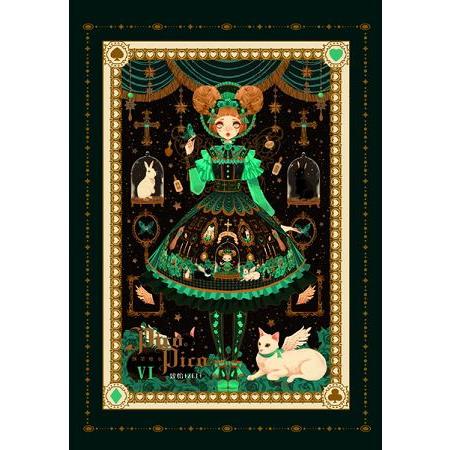[Food in Books] The Devil's Feast (The Blake & Avery Mystery Series #3) - M.J. Carter
*
Note:
I almost feel like I'm spoiling too much, for there really are tons of food mentioned in this book. But then I feel like it wouldn't be fair if I didn't treat it the same as I did all my "list of food in books" posts, alas, you are in for a treat.
I feel obliged to mention that the text copyright obviously belongs to the great M.J. Carter, and DO READ THE BOOK, because not only is the food in it great, the actual plot is also very savory. I myself first read it through a digitized US ARC provided by NetGalley, then got the UK ebook, THEN ORDERED the UK HARDBACK. Don't say I didn't go out of my way to support it. Love it, love it, LOVE IT!
- Ch. 1
- A covered bowl of cooling but tasty stew
- Ch. 2
- What was brought to Avery when he had the private talk with Matty
A large brown teapot, two cups, a plate of soft white bread and butter, another with slices of seed cake, and a saucer on which there were four tiny pairs of slightly crushed meringues pressed together with purple jam and a lick of whipped cream.
- Descriptions of the meringue
She watched as I placed a meringue in my mouth. It crumbled and vanished like a sugar cloud.
‘Chef calls them “a little piece of the divine”.’
- Ch. 3
- A splendid jar of vivid green peas
- The dinner, part 1 (the wine is white burgundy)
Mr Percy, the steward, whom I had met earlier, arrived and poured the wine – a deep, transparent gold – into eleven small glasses. A waiter served each of us with a morsel of lobster in a buttery sauce flavoured very gently with Indian spices laid inside a small, crisp, layered pastry case or vol-au-vent. It was so light one almost inhaled it. The wine, scented with butter and honey, was gone all too soon.
How shall I describe it? Vivid, surprising, complicated, delicious. I had never tasted the like. We began with a soup of early asparagus, light yet intensely flavourful, then turbot in a delicate pink sauce of lobster roe, then a whole salmon trout, remarkably suspended in aspic as if at the moment just before it took the hook.
Then the first of the ‘removes’ arrived: braised pigeons with asparagus and peas, and an extraordinary construction made of pastry in the shape of a crown, stuffed with small poached chickens which had in turn been stuffed with mushrooms, ox tongues and sweetbreads. Into the pastry crown’s sides had been stuck little golden skewers on which were strung slices of truffle and pink crayfish tails. We applauded wildly. Soyer described it as his little trompe l’œil, and said again that he was confident no one had ever seen anything like it and it would astonish the guests at the banquet.
There was a small pause while we were entertained with hors d’œuvres – among them a fresh salad of celery, young onions and sliced radish, another of haricots verts, early green beans dressed in a warm brown butter, and tiny crab rissoles.
Under Percy’s supervision, the napery was removed to reveal a new, fresh white tablecloth, then the footmen brought the dishes. First came a plate of crisp, white duckling with a sauce of sour oranges, a capon stuffed with black truffles and dressed with watercress and a ham in a Madeira sauce.
‘No one carves as skilfully as Mr Percy,’ said Soyer. ‘I yield to him the floor.’ Percy set about his work. Soyer was right: he carved with great skill, every perfect slice finding its way faultless on to our plates.
After this there was a warm terrine of quail and chicken, peas stewed with lettuces, small, buttery omelettes flavoured with herbs, and a delicious dish of tripe between unctuous layers of leeks, onions and carrots, which I would have thought would be far too rustic for the Reform’s table.
- A glass of a first-rate claret
- The entremets Avery was able to remember
I lost count of the entremets, but recall particularly tartlets filled with crystallized pineapple and an airy mousse that seemed to vanish as you tasted it.
- ‘Behold, a joint of British beef, turnips, apples and peas, and my special sauce Victoria!’
‘I see!’ cried Mr Blackwell. ‘It is a cake! Monsieur Soyer – quite extraordinary. Bravo!’
It was true: the whole dish was a dessert, got up to resemble an entrée.
‘Another little illusion of mine to stimulate the eyes as well as the tongue,’ said Soyer. ‘The beef is in truth a light sponge, carved and iced. Inside, there is fruit and whipped cream. The turnips and apples are frangipane, the peas are early greencurrants, the sauce is a crème aux fruits.’
- A tiny spoon of refreshing rosewater ice
- Ch. 4
- A small tray of tiny tartlets, each one filled with a shiny yellow custard and topped with a dark cherry
The first sensation was warmth and crispness but, just as one appreciated this, the tart melted on the tongue. The filling was an almond cream, not thick like a paste but whipped and airy. The cherry, which had slumbered in brandy since its harvesting, trembled then burst gloriously.
- A soupçon of this sole à la maître d’hôtel (fish)
- Ch. 7
- Hot fried fish (wrapped in old news sheets, doused with vinegar and finger-burningly hot)
- Ch. 8
- In the premises of Crosse and Blackwell
In the shining plate-glass windows there were elegant bottles of maraschinos and marsalas arranged on velvet cushions. Small jars of essence of anchovies stood next to large jars of bright green vegetables: cucumbers, green tomatoes and peas.
- Ch. 9
- What Matty and Mrs Relph worked on
Matty was slicing fruit: perfect grapes, pineapples and oranges. Next to her, Mrs Relph was stirring a cream of the palest lemon hue.
- What Avery ordered for Blake
I summoned a footman to go down to the kitchens and request milk, an uncooked egg, bread and butter and a hearty soup.
- Ch. 10
The fare was simpler than Soyer’s dinner, but no less satisfying for that. A velvety vegetable soup, followed by three small plates of French olives, anchovy fillets and crisp, bitter radishes with butter. Jerrold and Mayhew ordered roast beef served with early spring vegetables, some small potatoes basted in butter and chopped herbs, and I chose Soyer’s famous dish, lamb cutlets à la Reforme, as well as a late winter salad of herbs and cress. Percy, who periodically patrolled the Coffee Room, came to carve their beef, a great roast of which rolled up on a silver platter, his knife sliding through the meat like a diver penetrating water.
- Stewed rump steak with oyster sauce (Soyer’s dish, admired by William Thackeray)
- Veal chop and œufs en gelée (what Thackeray ate that night)
- Ch. 12
- What the victims ate (pineapple cream = Le crème d’ananas)
They had begun with potage à la Victoria, a cream-of-artichoke soup. Then Addiscomb had had roast rib of beef, turnips and greens, and Rickards lamb cutlets à la Reforme. They had followed these with a salad of winter herbs with ham, and celeri a la moelle de bœuf, celery with beef marrow. Dessert was jelly with mixed fruits and pineapple cream. They had drunk two bottles of claret, some sherry, coffee and some port to end with.
- Ch. 14
- An omelette aux fines herbes with a little salad
It occurred to me that I had never seen Soyer cook. He took a long phosphorous match and placed it against a pipe in one of the compartments on the top of the vast stove. In a moment, a flame danced up. He did the same with a second compartment, and set a frying-pan on each. With nonchalant elegance, he cracked a dozen eggs one by one into a white china bowl, then filled his fingers with salt from one of the little crocks nearby and cast it across the mixture. He did the same with a pinch of ground pepper, then poured from a jug a stream of thick cream into the eggs. He beat them briskly with a fork in wide circles, his hands moving with the same easy grace and precision as I had noted in Perrin. The eggs seemed almost to leap into the air as the whisk lifted them up and brought them back into the bowl. Soyer placed a perfect square of lemon-white butter into each frying-pan and brandished each pan in turn over its flame. The butter began to emit a very gentle hiss. Then he seized the white bowl and poured out the mixture, dividing it between the two pans and stirring each gently with a wooden spoon. The butter in the pans hissed louder. For a few seconds he simply watched the mixture settle, then he added a pinch of herbs to both and began carefully to agitate the pans, one and then the other, and, taking up a metal tool rather like a flat spade, worked quickly around the edges of each, prodding, scooping and tucking. After some minutes he picked up each pan and tapped it on the stove, then he turned a knob on the front of the range and, miracle of miracles, the flame was at once extinguished.
He set down the pans where the flame had been. The egg mixture continued to sizzle and steam. When the hissing ceased, he took his metal tool and folded each omelette upon itself. Then he tipped each pan, letting the concoction slip elegantly on to a large blue plate. This he brought to the table. Two perfect, soft, unblemished yellow semicircles, smooth and shiny as porcelain. Mr Percy divided them neatly among eight plates. Perrin put a little salad on to each plate and broke the bread with his hands, and we all came to the table.
‘Un repas paysan,’ Soyer said, ‘the food of peasants. Honest, and none the worse for that.’ He picked up his bread, pulled open the crust so the soft, velutinous white inside was exposed, pushed it into a piece of omelette, then lifted the dripping morsel to his lips and bit upon it.
- Ch. 17
- A pie (bought by Avery for Matty)
- Ch. 18
Bentley and Adams’s stood out from its row of stalls by virtue of its long frontage and the elaborate arrangement of its fruits and vegetables. Outside, there were boxes of potatoes and carrots, onions and cauliflowers, leeks and beetroots, piled upon each other. At the stall’s entrance a display of handsome asparagus and rhubarb, young carrots, radishes, the first small lettuces and a few very early peas. Below, boxes of luminous oranges and lemons. Clearly, the stall regarded itself as well above the cut of the other vegetable merchants.
- Ch. 20
- Cutlet (Marius failed; Francobaldi took over and demonstrated himself)
- A plate of fish (prepared by two cooks of the Union Club)
A perfect square of milky white flesh atop a pale mousse flecked with green.
- Ch. 21
- Soyer’s recipes Morel passed to Francobaldi (written in codes)
Crayfish in champagne, Soyer’s lobsters with plover’s eggs.
- Ch. 22
We began with the soups. For me, potage à la Victoria, a pale golden, thickened veal broth garnished with parsley and cockscomb seeds. My spoon trembled slightly as I brought it to my lips. I grinned and took it. It seemed to me the acme of warmth and meaty fragrance; made the more so, I suspected, by the lingering sense of danger. I took another mouthful.
‘No need to overdo it,’ said Blake.
Molesworth looked up from his Comte de Paris, a dark-hued consommé in which delicate ribbons of macaroni and tiny balls of chicken mousse floated. He raised an eyebrow.
Blake, meanwhile, tasted potage à la Colbert, a vegetable soup with tiny dice of Jerusalem artichokes, all cut perfectly identically to the size of peas. Percy tried a potage à Louis Philippe, named after the current, undeserving incumbent of the French throne, a soup flavoured with stock and turnip, to be finished with cream and the first impossibly thin asparagus just before serving. Soyer stook sips of everything. We waited a few minutes. No strange tastes, we agreed.
- The early tasting: various sauces for the fish
The fish would have to be tried much closer to its serving, as would most of the meat dishes. Waiters, each accompanied by a soldier, brought in the various sauces for the fish: I had a sauce Mazarin, a creamy concoction of the soft, coral roe of a lobster, destined for a poached turbot, while Lord Marcus tried a fragrant sherry sauce that would dress a salmon trout, and Percy the cream gratin for a dish of Severn salmon that was due to arrive at any moment. Soyer returned to the kitchen.
- The early tasting: garnishes and braises
We passed on to the garnishes and braises: miraculous veal quenelles for me; a frothy asparagus purée, a stuffing of truffles and mushrooms for capons, braised ox tongues, poached crayfish and fish quenelles for the others.
- Veal sweetbreads and puréed cucumbers (tasted by Molesworth)
- The early tasting: entremets & desserts
No more was said. Of the entremets, I essayed curried lobster balls, but we were forced to leave most of the vegetables, for they would not be cooked until the last minute, and went on to the first of the prepared desserts. I had brandy-soaked cherries in little, round, hard toffee cases, elaborately domed meringues, charmingly shaped fruit jellies to be served on beds of whipped cream, small, crisp apricot tarts and little squares of sugared pineapple jelly bonbons.
- Soyer’s giant dessert assemblages: pièces montées
They were to be put together at the last minute, for they could only hold together for so long before collapsing into a puddle of cream, sponge and soggy fruit.
The least ambitious of these was a concoction of meringues assembled into the shape of a Chinese pagoda, with early strawberries and Soyer’s elaborate joke of lamb cutlets that revealed themselves, on closer inspection, to be cake, cream, frangipane and icing. There were two further large assemblages.
- The gâteau britannique à l’Admiral (the British admiral’s cake)
A pale sponge had been carved into the shape of a man-of-war and iced with rice-paper versions of the Egyptian and English flags. Within it would be placed chilled, sliced fruits and iced peach mousse.
- The crème d’Égypte â l’Ibrahim Pasha
A dessert in the shape of a pyramid in which light meringue cakes had been carved into the shape of the great square stones of the pyramid, mortared with a pineapple cream and faced with thin, transparent sheets of spun sugar. On top of this would be placed a portrait of Mehmet Ali Pasha, also in spun sugar, and underneath it, etched upon jelly and framed with gold leaf, a portrait of Ibrahim Pasha himself.
- Great haunches of mutton from the South Downs (the relevés)
- A vast baron of roast beef on an almighty platter (the roasts)












No comments:
Post a Comment